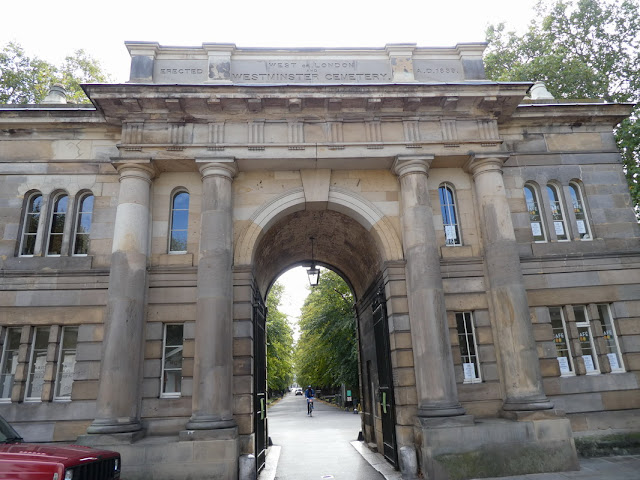Out of the Magnificent Seven cemeteries in London, Brompton was the last for me to visit. It is located by West Brompton station and close to Earls Court, the old Exhibition Centre is across the road from the cemetery, and the Stamford Bridge stadium (home of Chelsea football) to the south.
The north entrance gate says West of London and Westminster Cemetery, erected 1839. The cemetery was opened in 1840.
Brompton is the most symmetrical of the seven cemeteries, with neat rows of graves and paths and a Central Avenue. The place is very popular with joggers.
Because of its "neatness" I found it a bit less exciting than the other cemetries. Also there were very few names that I recognised who were buried there. However several graves featured a pile of rocks, which I hadn't seen elsewhere. These are known as the rock of faith. General view -
Dr Benjamin Golding was a medical pioneer who founded Charing Cross Hospital. To the left of his tomb is one with a pile of rocks.
A broken column often symbolises someone who passed away in the prime of life, often the head of a family. Henry Pettitt died from typhoid aged 45. He was a popular and prolific Victorian dramatist, famous for his melodramas.
One name I did know,
Emmeline Pankhurst, a passionate and fearless campaigner for the rights of women. She died 1928.
I liked the winged cherubs with a bowl on Central Avenue, the grave of Albert Emile Schloss -
Looking down Central Avenue towards the Great Circle.
More graves with rock piles -
There aren't many big tombs in Brompton. This one is quite elaborate, James McDonald, a Scottish-American oil magnate whose mausoleum is watched over by angels. He died in 1915 in Washington and his remains were only returned after the War, he was interred in Brompton in 1920 -
Leaving Central Avenue -
Yew tree
John (Gentleman) Jackson was a boxer. A prize fighter, he became a bodyguard at King George IV's coronation. He died aged 76 and was honoured with a monument with a carved lion on his tomb costing upwards of £400 which was provided by his many friends and admirers
The Great Circle and Colonnades - Two long colonnades embrace the Great Circle, possibly inspired by St Peters in Rome. There are catacombs beneath.
The chapel -
The
catacombs were underground vaults built to hold thousands of coffins. They have impressive cast iron doors -
Reginald Warneford VC - Charismatic ‘Reckless Rex’ is one of the cemetery’s 12 Victoria Cross holders. He died aged just 23. Ironically, after his war efforts, he was doing a test flight when his plane suffered a wing failure and crashed and he died from his injuries.
Cedar of Lebanon -
The holm oak aka holly oak is one of the few evergreen oaks in England and is known as a sacred tree -
The
Strawberry Tree is an evergreen from the Mediterranean. The fruit were just starting to turn red -
The Chelsea Pensioners Monument, erected 1901 -
The infantry section - An elegant marble cross stands guard over a field of eighteen white headstones, marking the burial place of many hundreds of peacetime casualties from the Brigade of Guards between 1854 and 1899
There was a modern section, this lady obviously loved Christmas -
Throughout the cemetery there were many pigeons and squirrels. People were feeding the latter and they were very tame. Sadly I didn't take any peanuts with me
This board gives interesting information about features found on graves -


































































